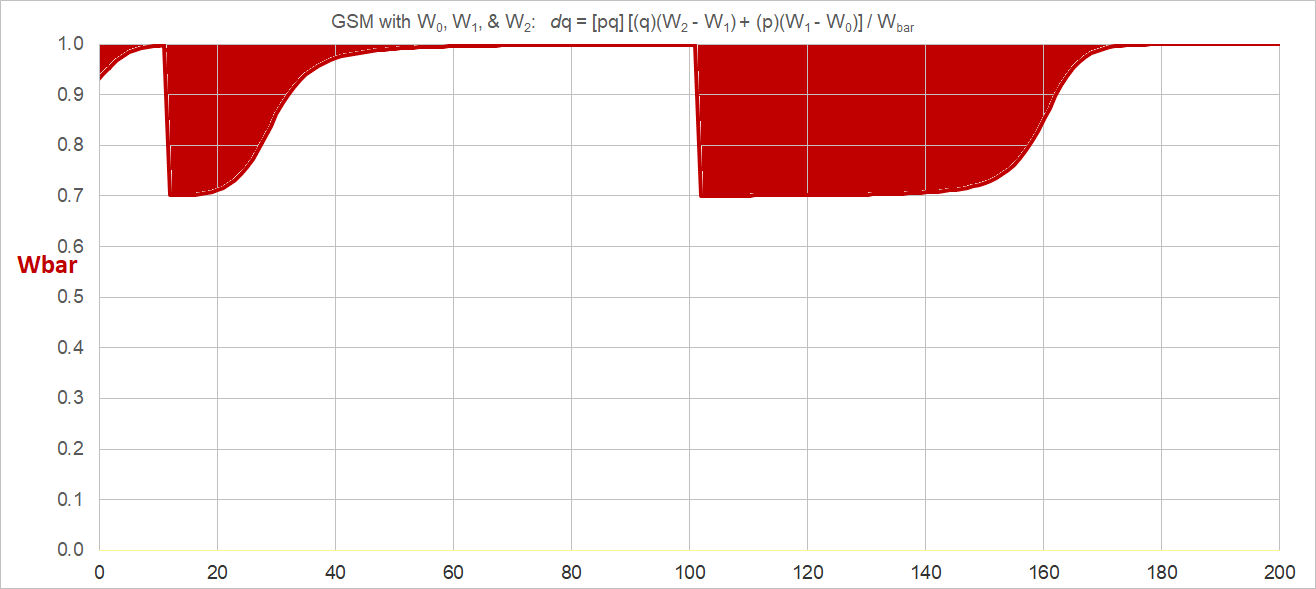Substitutional Load is the
theoretical loss of fitness to a population during the
interval over which a deleterious allele is replaced ("substituted")
by an advantageous allele. This load may be estimated as the
difference between the observed Mean Fitness (" ")
and the optimal fitness (
")
and the optimal fitness ( = 1.0) in any one generation of
selection, summed over all generations during substitution.
In the Pepper Moth (Biston betularia)
exercise, over the first 10 generations, the population is
at a slightly sub-optimal fitness because of the presence of
the 'carbonaria' allele, which generates a
small fraction of dark moths in an otherwise light
population. Over the next 90 generations, when the
environment changes to favor the dark form, the population
is suddenly at a substantially lower fitness, because the
predominant light form is less fit. The curve is that
expected for a advantageous dominant allele replacing a
disadvantageous recessive allele. At the 100th generation,
relative fitness again reverses to favor the light moths
over the dark. Under these circumstances the curve is that
expected for an advantageous recessive allele replacing a
disadvantageous dominant allele. Note that the cumulative
substitutional load is much greater than in the previous
allelic substitution.
= 1.0) in any one generation of
selection, summed over all generations during substitution.
In the Pepper Moth (Biston betularia)
exercise, over the first 10 generations, the population is
at a slightly sub-optimal fitness because of the presence of
the 'carbonaria' allele, which generates a
small fraction of dark moths in an otherwise light
population. Over the next 90 generations, when the
environment changes to favor the dark form, the population
is suddenly at a substantially lower fitness, because the
predominant light form is less fit. The curve is that
expected for a advantageous dominant allele replacing a
disadvantageous recessive allele. At the 100th generation,
relative fitness again reverses to favor the light moths
over the dark. Under these circumstances the curve is that
expected for an advantageous recessive allele replacing a
disadvantageous dominant allele. Note that the cumulative
substitutional load is much greater than in the previous
allelic substitution.
The actual effects of allelic
substitution in a population are variable. In the first
stage of the example, the presence of a small number of dark
moths likely does not change the total population size N.
Even in the second and third stages, population size is
unlikely to be reduced as much as (1 -  )
= 30%, as N will tend to stay near the
carrying capacity K despite increased predation on
the non-cryptic form. That is, where natural selection is "soft",
actual loss of population fitness may be negligible. On the
other hand, the relatively sudden environmental change in
stage 2 renders the large majority of the population liable
to predation, and a drop in N at least initially
might be expected. "Hard" selection occurs when the
predator birds form a 'search image' that targets the
non-cyptic form almost exclusively.
)
= 30%, as N will tend to stay near the
carrying capacity K despite increased predation on
the non-cryptic form. That is, where natural selection is "soft",
actual loss of population fitness may be negligible. On the
other hand, the relatively sudden environmental change in
stage 2 renders the large majority of the population liable
to predation, and a drop in N at least initially
might be expected. "Hard" selection occurs when the
predator birds form a 'search image' that targets the
non-cyptic form almost exclusively.
Note that substitutional load could also
be estimated by integrating the area above the curve from a
knowledge of its generating function.
Figure & text © 2024 by Steven M. Carr

